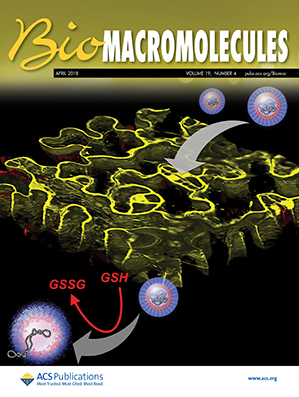Redox-Responsive PEO‑b‑PCL-Based Block Copolymers for Synergistic Drug Delivery and Bioimaging in Cancer Cells
IF 5.4
2区 化学
Q1 BIOCHEMISTRY & MOLECULAR BIOLOGY
引用次数: 0
Abstract
Stimuli-responsive polymer-based nanocarriers enhance the drug delivery efficiency by enabling targeted release at tumor sites. However, integrating therapeutic and diagnostic functions into a single nanoplatform while maintaining control over both remains a significant challenge. This study presents a stimuli-responsive, multifunctional poly(ethylene oxide)-b-poly(ε-caprolactone) (PEO-b-PCL) nanocarrier for combination cancer therapy and bioimaging. The system codelivers chlorambucil (CHL) and methotrexate (MTX) to enhance therapeutic efficacy and overcome multidrug resistance. A redox-responsive disulfide linker enables CHL release in the tumor’s glutathione-rich environment, ensuring selective drug activation. Additionally, an aggregation-induced emission (AIE) fluorophore, tetraphenylethylene (TPE), facilitates the monitoring of cellular uptake and drug release. The resulting TPE-(PEO-b-PCL)-S–S-CHL (P3) micelles encapsulated with MTX (P3-MTX) exhibited favorable size, morphology, and enhanced cytotoxicity, demonstrating a synergistic effect in combination therapy. Confocal laser scanning microscopy (CLSM) confirmed intracellular uptake by using TPE-based fluorescence. Thus, these nanocarriers offer a promising theranostic platform for simultaneous cancer treatment and monitoring.
- Download: Download high-res image (202KB)
- Download: Download full-size image
基于peo -b- pcl的氧化还原响应嵌段共聚物在癌细胞中的协同药物传递和生物成像。
刺激反应聚合物基纳米载体通过在肿瘤部位靶向释放来提高药物递送效率。然而,将治疗和诊断功能集成到一个纳米平台上,同时保持对两者的控制仍然是一个重大挑战。本研究提出了一种刺激响应的多功能聚(环氧乙烷)-b-聚(ε-己内酯)(PEO-b-PCL)纳米载体,用于肿瘤联合治疗和生物成像。该系统联合给药氯霉素(CHL)和甲氨蝶呤(MTX),提高治疗效果,克服多药耐药。氧化还原反应二硫连接体使CHL在肿瘤的谷胱甘肽富集环境中释放,确保选择性药物激活。此外,聚集诱导发射(AIE)荧光团,四苯基乙烯(TPE),有助于监测细胞摄取和药物释放。MTX (P3-MTX)包裹的TPE-(PEO-b-PCL)- s - s - chl (P3)胶束具有良好的大小、形态和增强的细胞毒性,在联合治疗中显示出协同作用。共聚焦激光扫描显微镜(CLSM)通过基于tpe的荧光证实了细胞内摄取。因此,这些纳米载体为同时治疗和监测癌症提供了一个有希望的治疗平台。
本文章由计算机程序翻译,如有差异,请以英文原文为准。
求助全文
约1分钟内获得全文
求助全文
来源期刊

Biomacromolecules
化学-高分子科学
CiteScore
10.60
自引率
4.80%
发文量
417
审稿时长
1.6 months
期刊介绍:
Biomacromolecules is a leading forum for the dissemination of cutting-edge research at the interface of polymer science and biology. Submissions to Biomacromolecules should contain strong elements of innovation in terms of macromolecular design, synthesis and characterization, or in the application of polymer materials to biology and medicine.
Topics covered by Biomacromolecules include, but are not exclusively limited to: sustainable polymers, polymers based on natural and renewable resources, degradable polymers, polymer conjugates, polymeric drugs, polymers in biocatalysis, biomacromolecular assembly, biomimetic polymers, polymer-biomineral hybrids, biomimetic-polymer processing, polymer recycling, bioactive polymer surfaces, original polymer design for biomedical applications such as immunotherapy, drug delivery, gene delivery, antimicrobial applications, diagnostic imaging and biosensing, polymers in tissue engineering and regenerative medicine, polymeric scaffolds and hydrogels for cell culture and delivery.
 求助内容:
求助内容: 应助结果提醒方式:
应助结果提醒方式:


